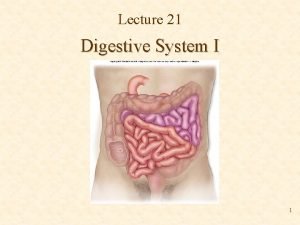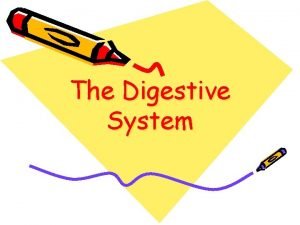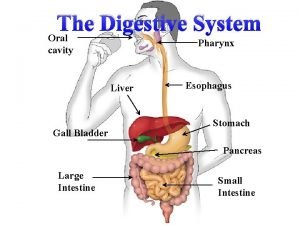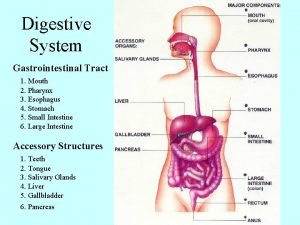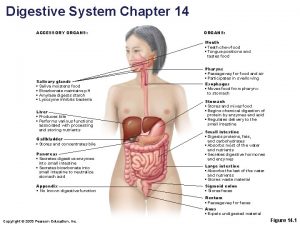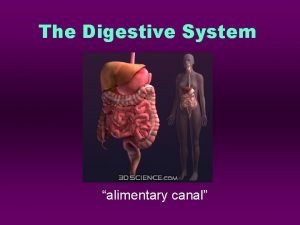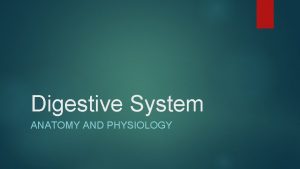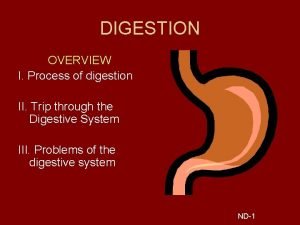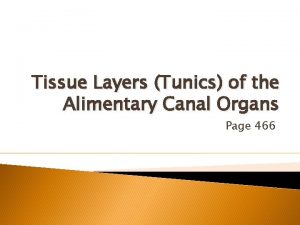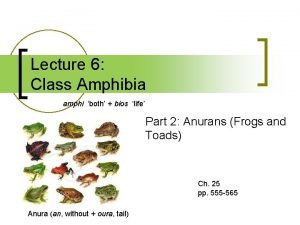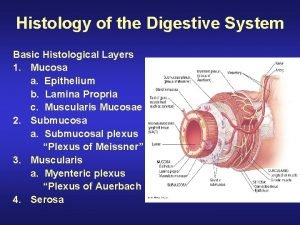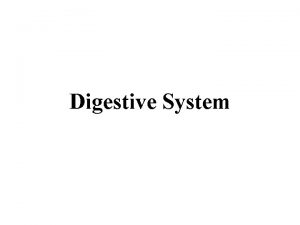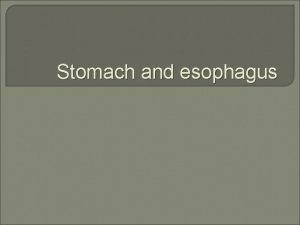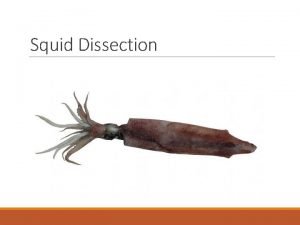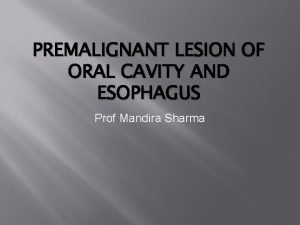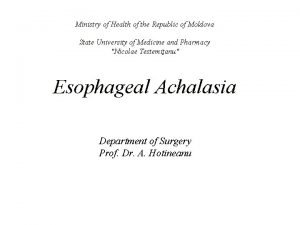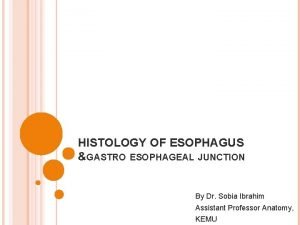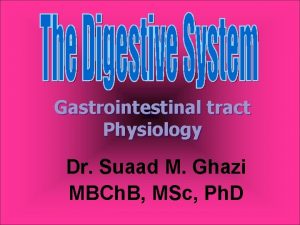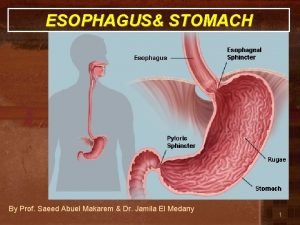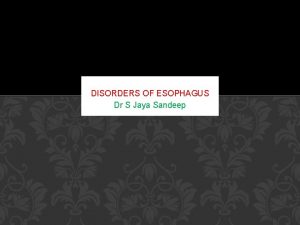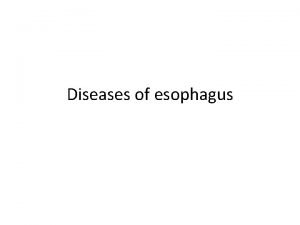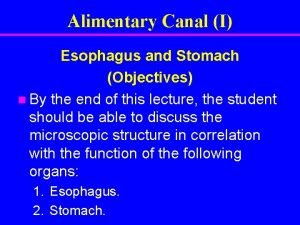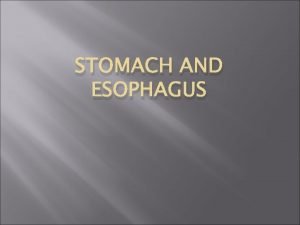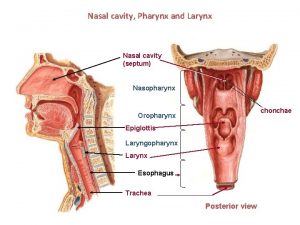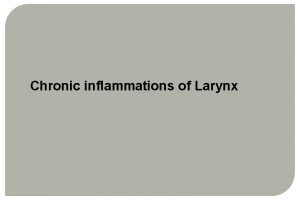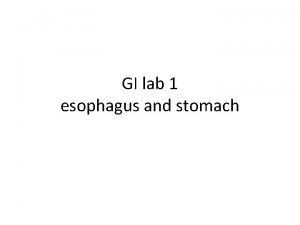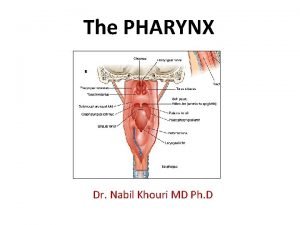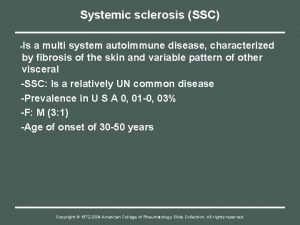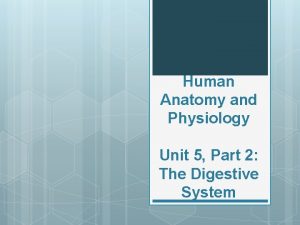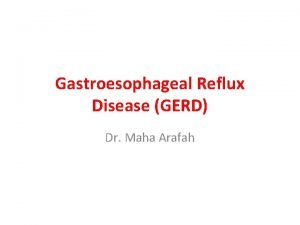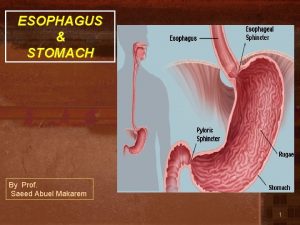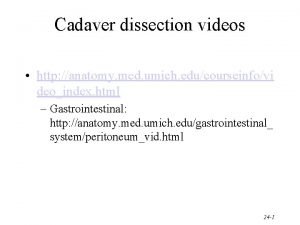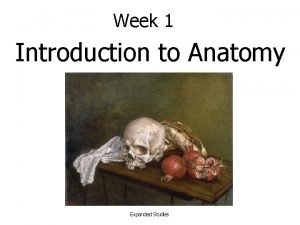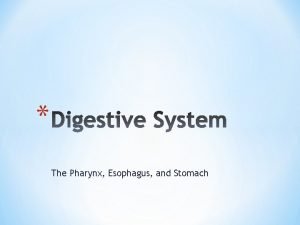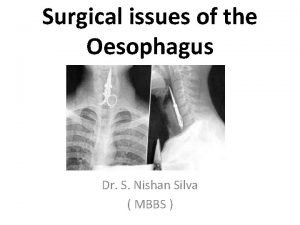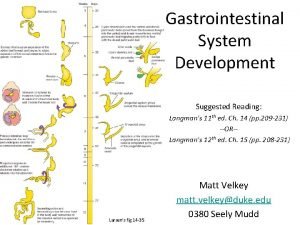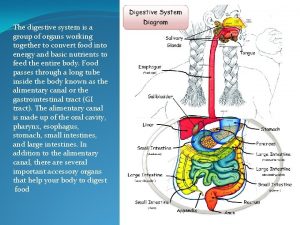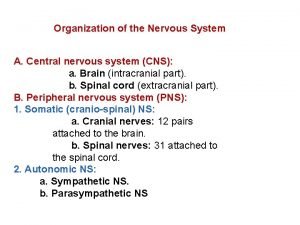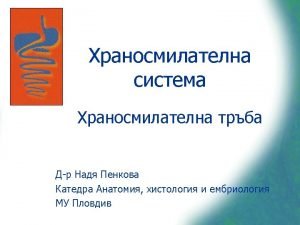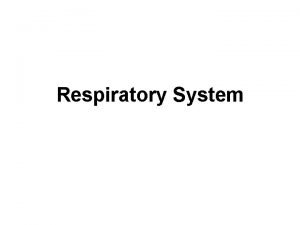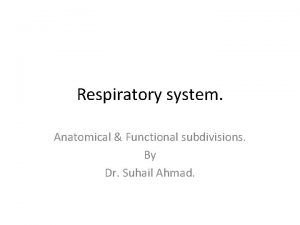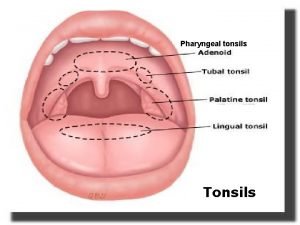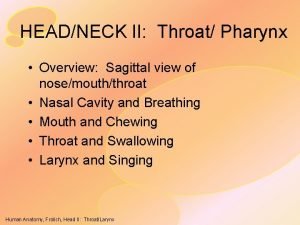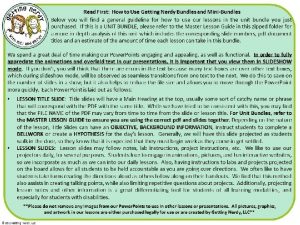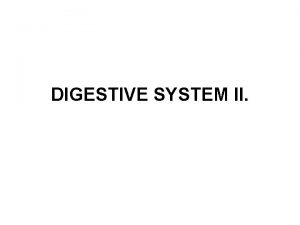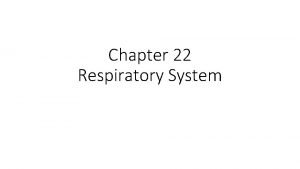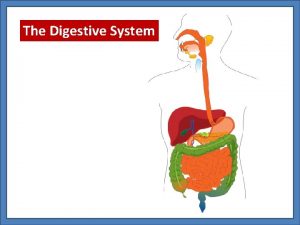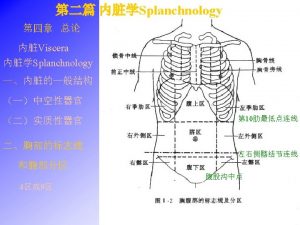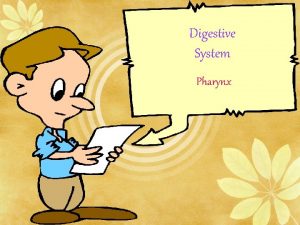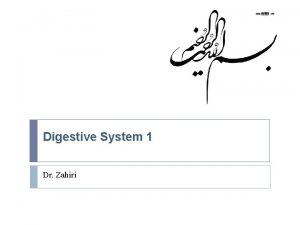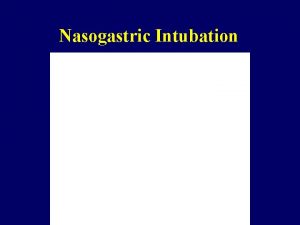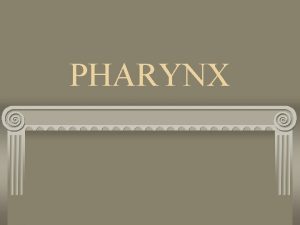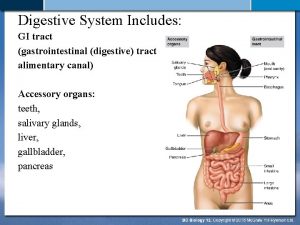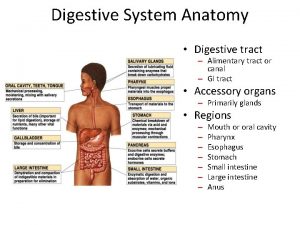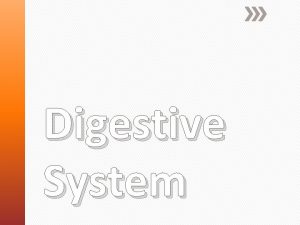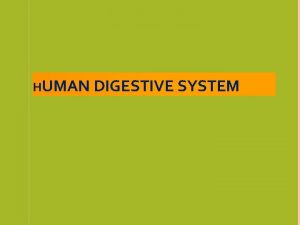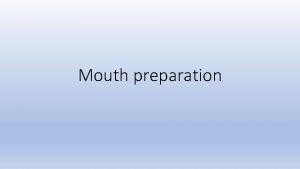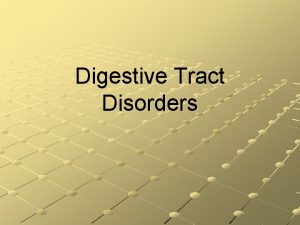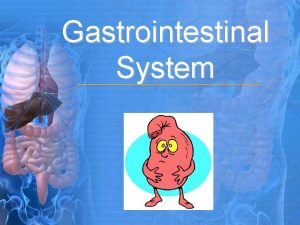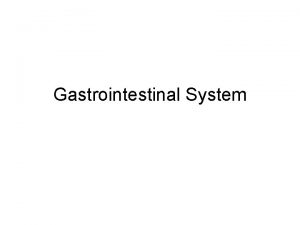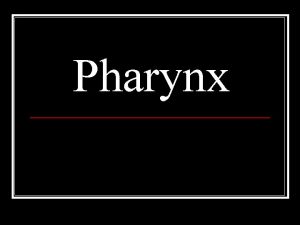The Digestive System Digestive Tract Mouth Pharynx Esophagus






























































- Slides: 62

The Digestive System

Digestive Tract Mouth Pharynx Esophagus Stomach Small intestine Large intestine Rectum Anus Accessory Organs/Structures Teeth Tongue Salivary Glands Pancreas Liver Gallbladder

Nutrition is the process of taking in food and using it for growth, metabolism, and repair. Nutritional Stages: Ingestion Digestion Absorption Transport Assimilation Excretion

Digestive Processes § Ingestion – taking food/drink into mouth. § Mechanical Digestion – Physical breakdown of food (chewing, churning). § Chemical Digestion – Enzymatic breakdown of chemical bonds from complex to simple. Polymers Monomers

§ Absorption – moving nutrients and digested products from lumen of G. I. tract to into the circulatory system (blood and lymph). inside body § Transport – Distribution of absorbed nutrients around the body via the circulatory system (blood and lymph). § Assimilation – Incorporation of newly acquired nutrients into body’s cells and tissues. § Excretion – elimination of indigestible and waste products from body (feces).


The Journey of Ingested Food • The GI tract is 25 to 30 feet long muscular ‘tube’ that makes the digestive tract. • 5 Organs (Regions) of GI Tract: – Mouth – taste, chewing, getting food into solution – Esophagus – bolus ready for transport down to stomach – Stomach - acidic chyme liquefies everything – Small Intestine – chemical breakdown and absorption – Large Intestine – water and ions absorption, compaction Sphincters are smooth muscle that open and close regions of the tract controlling food movement from one organ to the next.


Digestion Begins in the Mouth • Both Mechanical and Chemical Digestion begin in the mouth. – Mechanical: chewing, grinding, squeezing, – Chemical : Breaking down food via enzymatic reactions • Saliva – Dissolves small food particles. – Contains the enzyme lingual amylase, which begins to break down carbohydrate. Plus lysozymes (antibacterial). – *Lingual lipase in young, but in adults, no other chemical digestion of nutrients takes place in the mouth.

Tongue – contains taste buds on surface for 5 tastes: Sweet, Sour, Salt, Bitter and Umami Nose – together with olfaction (sense of smell), the basic tastes in the mouth combine with the fragrances to finely discriminate very specific tastes.

The Role of the Epiglottis

Mouth • Once adequately chewed and moistened, the tongue rolls food into a bolus and pushes into pharynx (throat) to be swallowed. • Esophagus transports bolus and fluids to stomach. • There are two sphincters in the esophagus: – Upper esophageal sphincter: Allows the bolus of food to enter the esophagus – Lower esophageal sphincter (LES): Allows the bolus of food to enter the stomach

The Stomach • The Stomach has more muscle layers than any other region! Mixes food with gastric juices and churns contents = Mechanical Digestion • HCl (p. H of 2) released to assist Protein Digestion • When empty stomach holds 1 cup…expands ~ 1 gallon! • Chyme (partially digested food) leaves stomach and enters the Small Intestine.

Anatomy of the Stomach Pyloric Sphincter - gateway for chyme to Small Intestine

Gastrointestinal Hormones Activate 2 nd messenger system to carry out the task, usually in the form of ATP or Calcium

Gastrointestinal Sphincters (Valves) Sphincter - a circular muscle acting as valves to regulate passage or flow of material. Including: • Upper Esophageal Sphincter • Lower Esophageal Sphincter - prevents backflow (reflux) or ‘heartburn’ of stomach. • Pyloric Sphincter controls movement of stomach contents into small intestine.

Sphincters at Work AKA cardiac sphincter Sphincters respond to stimuli from nerves, hormones and pressure

• Ileoceal Valve controls flow from the small intestine into the large intestine. • Internal Anal Sphincter – composed of Smooth muscle (involuntary control). • External Anal Sphincter – composed of skeletal muscle (voluntary control). • Once toilet-trained, a child knows when to relax the external sphincter and when to keep it constricted.

Small Intestine • 3 Segments in the Small Intestine: – Duodenum: 10 inches long – Jejunum: 8 feet long – Ileum: 12 feet long • Both Mechanical and Chemical Digestion occur here. • Pancreas squirts Pancreatic Juices into Duodenum for complete Digestion of everything! • Surface of small intestine highly specialize for Absorption - lined with villi to maximize absorption. • Contents may be in there from 3 to 10 hours, depending on the food eaten.


Large Intestine Absorbs Water & Electrolytes • About 5 feet long and 2. 5 inches in diameter. • The large Intestine has 3 main segments. – Cecum: The beginning of the intestine – Colon: The largest part of the intestine – Rectum: Final 8 -inch portion of the large intestine • Chyme enters large intestine via ileocecal valve. • Site of H 2 O, Na+, K+ and Cl- absorption. • Bacteria make vitamin K, thiamin, riboflavin, biotin, and vitamin B 12, only biotin vitamin K absorbed : (

Anatomy of the Large Intestine


The Large Intestine • Bacteria in colon ferment some undigested and unabsorbed carbohydrates (fibers) into simpler compounds, methane gas (CH 4), CO 2, and H 2. – Fermented fiber produces short-chain fatty acids. • In large intestine, 1 liter of fluid material is gradually reduced to 200 grams of brown fecal material. • The intestinal matter passes through the large intestine in 12 to 70 hours, depending on the person's health, age, diet, and fiber intake.

Large Intestine • Stool propelled through large intestine until it reaches the rectum, the last 8 -inch portion gut. • The anus is the opening of the rectum, or end of the GI tract. • The final stage of defecation is under voluntary control. *External Anal Sphincter and abdominal muscle Note: When bile is metabolized by your gut bacteria, it makes stercobilin = brown-ish.

Accessory Organs • Extrinsic Salivary Glands – Dissolve small food particles to lubricate food. – In preparation for swallowing bolus – The body produces 1 quart of saliva per day. . Saliva contains water, mucus, electrolytes, immunoglobbulins and a few enzymes

Accessory Organs • Liver – Largest internal organ of body, wt = ~3 lbs. – Major role in digestion, absorption, and transport of nutrients. – Essential in carbohydrate metabolism. – It makes Proteins. – Hepatocytes make bile used to Emulsify Fats. – Site of alcohol metabolism – Removes and Degrades Toxins & Excess Hormones.

Accessory Organs • Gallbladder – Stores Bile from the liver via common hepatic duct – Concentrates Bile – Releases Bile to small intestine via common bile duct • Pancreas – Exocrine Gland: Secretes digestive enzymes into the small intestine (pancreatic juices!) – Endocrine Gland: Releases Hormones to maintain blood glucose levels: Insulin and Glucagon.

Propelling Food through the GI Tract • Food propelled along GI tract by strong muscular contractions. • Two primary contractions are: – Peristalsis: Squeezes food forward through the GI tract (Mechanical Digestion) – Segmentation: Shifts food back and forth along the GI tract in the intestines and adds chemical secretions *Allows more contact with surface of small and large intestines and increases absorption.

Peristalsis and Segmentation

How Is Food Chemically Digested? Digestive Enzymes Catalyze (speed up) Reactions: Hydrolysis • Chemical rxn uses water (H 2 O) to split chemical bonds of digestible nutrients. • The hydroxyl group (OH) from water joins one molecule while the hydrogen ions (H) joins the other molecule. – Also Regulated by Hormones – e. g. , Gastrin, CCK, Secretin, GIP, Ghrelin, Leptin, Chemical Digestion Completed by the time Food reaches the Large Intestine

A Digestive Enzyme in Action

3 Conditions Required for Enzymes to Work 1. The compatible enzyme and nutrient are both present, e. g. Sucrase hydrolyzes sucrose. 2. p. H of surroundings must be in optimal range. • Outside of that range of acidity and alkalinity, the enzyme activity is decreased or halted. 3. Temperature of environment must be optimal. • Enzyme activity is slowed if temperature too low and halted if temperature is too high.



How Are Digested Nutrients Absorbed? Vast majority of absorption occurs in Small Intestine Nutrients are Absorbed via: Passive Diffusion: Nutrients move from high concentration to low concentration; no E required. Facilitated Diffusion: Nutrients move from high concentration to low concentration with the help of a carrier protein; no E is required. Active Transport: Nutrients move from low concentration to high concentration with the help of a carrier protein; E is required. Endocytosis: Cell forms a vesicle to surround and engulf a nutrient. E is required

4 Methods of Nutrient Absorption in the Small Intestine

Fluid Absorption Occurs in the Large Intestine • Majority of nutrients already absorbed when chyme enters the large intestine. • Water and Electrolytes are absorbed Here! • Same mechanisms used in the small intestine are also used in the large intestine. – Water: Passive Diffusion – Sodium: Active Transport

How Do Hormones and the Nervous System Regulate Digestion? • The Endocrine and Nervous Systems together coordinate digestion, absorption, and excretion of waste products. • Endocrine System communicates with the nervous systems built into the GI tract, called “Enteric” NS • Enteric Nervous System controls Digestion with a network of nerve fibers that innervate the GI tract, pancreas, and gallbladder. • Enteric Nerves monitor stomach contractions after eating and the secretions of the cells in the GI tract.

Hormones in the GI Tract Regulate Digestion • Hormones regulate digestion by controlling: – Release of gastric and pancreatic secretions – Peristalsis – Enzyme Activity • Enterogastrones are produced and secreted by the cells lining the stomach and small intestine. – Influence GI motility, stomach emptying, gallbladder contraction, intestinal absorption & hunger. – Release of hormones is stimulated by the types of food passing through the digestive tract.

Gastrointestinal Hormones – Gastrin: Triggered by food in stomach - stimulates acid (HCl) release and gastric enzymes (commence!) – Secretin: Triggered by acidic chyme & partially digested proteins – stimulates pancreas to release bicarbonate (base) to small intestine; p. H is raised – Cholecystokinin (CCK): Triggered by fat and proteins, stimulates the pancreas to release lipase and the gallbladder to release bile; (slows down gastric motility). – Gastric Inhibitory Peptide (GIP): Inhibits gastric motility and stomach secretions.

Hormones Communicate Hunger and Satiety • Ghrelin - triggers hunger; released by stomach, pancreas goes to feeding center in Hypothalamus. Inhibited by glucose but not fructose • Leptin – Triggers satiety center in hypothalamus signals satiety center which turns OFF the feeding center. Released by adipocytes in fat tissue.


The Nervous System in GI Tract • Nervous System sends information about when to eat and drink, and when to stop. • Extrinsic Nerves: – Communicate changes in the GI tract and stimulate motility – Originate in the brain or spinal cord • Intrinsic Nerves: more neurons than brain! – Receive message from extrinsic nerves & respond by stimulating the release of digestive juices – Interwoven in the linings of the esophagus, stomach, and small and large intestines

Blood and Lymph Receive Nutrients • Fat-soluble nutrients are absorbed into the lymphatic system first, then delivered to blood. • Fat-soluble vitamins, long-chain fatty acids, proteins too large to be transported via the capillaries. Large Intestine and Kidney Eliminate Wastes • The waste products that remain after nutrient absorption are removed by the excretory system. • Kidneys filter the blood, allowing waste products to be concentrated in the urine and excreted.

What Are Some Common Digestive Disorders? • Digestive Disorders From Minor to Serious. Include: • • Ulcers Gallbladder disease Celiac disease Flatulence Diarrhea/constipation Belching Gastroenteritis • • Hemorrhoids Irritable bowel syndrome Ulcerative colitis Diverticulitis Crohn's disease Colon cancer Heartburn

An Ulcer and Gallstones A hole in the lining of the tract! Gastric and duodenal. Bile, billirubin or cholesterol become too concentrated in gallbladder!

Celiac Disease • A genetic autoimmune disorder damages small intestine when foods containing gluten are consumed • Causes the villi of small intestinal to flatten out, causing nutrient malabsorption

• Caused by an inflammatory response to the protein gluten, found in many grains (wheat, rye, barley, oats). Increased risk for • Symptoms osteoporosis, stunted – Reoccurring abdominal bloating growth, seizures – Cramping and/or gas Treatment - Follow a gluten-free diet. – Diarrhea Eliminate all foods that contain wheat. – Foul-smelling stools Include milk, meat, eggs, fruits, vegetables, rice, potatoes, beans, millet, amaranth. – Weight loss Moderate amounts of oats ( ¼ c) may be – Anemia tolerated. – Bone or joint pain

• Flatulence Results from the formation of intestinal gas. Most adults release 10 to 20 times a day. – Caused by: • Foods high in fiber (*fermentable) and starch • Eating too quickly • Drinking carbonated beverages • Lack of Exercise • Smoking? • Poor Food Combining (e. g. fruits w/Pro-s)

• Diarrhea: Passage of watery, loose stools more than 3 times/day. – From bacterial, viral, or parasitic infections - food and fluids to pass too quickly through colon. – Chronic diarrhea sign of more serious problems? – Untreated diarrhea can lead to malnutrition. – Can lead to dehydration and potentially death, (esply children and elderly). – Treated with fluid and electrolyte replacement

• Constipation: Infrequent passage of dry, hardened stools. – Often due to insufficient fiber or water intake – Other causes include stress, inactivity, quitting smoking! And various illnesses. – Treatments: • Exercise, improved eating patterns, and proper rest. • Laxatives… sparingly, they cause dehydration, salt imbalances, and laxative dependency. • Colon cleansing (enema) as a treatment?

• Hemorrhoids: Inflamed, swollen and herniated veins of the rectum and anus – Can lead to bleeding, itching, and/or pain. – May be from straining to pass dry stools, pregnancy, constant constipation or diarrhea.

• Hemorrhoids: – Treatments: Increased dietary fiber and fluid intake. Itching and pain may be relieved with ointments, ice packs, and soaking in a warm bath. Severe cases may require surgery. Hematochezia - passage of fresh (bright red) blood through the anus, usually in or with stools. Commonly associated with lower gastrointestinal bleeding.

• Irritable Bowel Syndrome (IBS): Changes in Colon Rhythm – Those with IBS experience an over-response to colon stimuli, resulting in alternating patterns of diarrhea, constipation, and abdominal pain. Exact cause unknown – Treatments: – Increased dietary fiber – Stress management – prescription drugs


• Ulcerative Colitis: A chronic inflammation of the large intestine, resulting in ulcers in the lining of the colon – Tends to run in families – Afflicts both men and women, from ages 15 to 30 – There is no known cause or cure. – Treatment includes drug therapy and surgery.

Diverticulitis results when one of these diverticula becomes inflamed (or infected). Treatments: – Increase Dietary Fiber – Ingest Less Toxins

• Diverticulitis: Typically occurring in the colon, Diverticulitis involves the formation of pouches called “diverticula” within the bowel wall. • This is called Diverticulosis

• Crohn's Disease: Similar to ulcerative colitis, but ulcers can occur throughout entire the GI tract – There is no known cause or cure. – Treatments? Ulcerative Colitis Crohn’s Disease Polyp

• Colon Cancer: The 2 nd leading cause of cancer death, but one of the most curable cancers if detected early – begins with polyps on the lining of the colon that are often small, benign, and can be surgically removed. • Polyps… cancerous tumors if not detected early. Treatment includes … – Survival rates vary depending on age, treatment response, and stage of cancer diagnosis.

 Pyloric orifice function
Pyloric orifice function Digestive system for labelling
Digestive system for labelling Digestive system model
Digestive system model Extrapyramidal tract names
Extrapyramidal tract names Dorsal reticulospinal tract
Dorsal reticulospinal tract Git layers
Git layers Function of mouth in digestive system
Function of mouth in digestive system Ingestion digestive system
Ingestion digestive system Diagram of alimentary canal
Diagram of alimentary canal Polyp vs medusa
Polyp vs medusa Function of duodenum
Function of duodenum Major function of digestive system
Major function of digestive system Digestive system end
Digestive system end Alimentary canal tunics
Alimentary canal tunics Digestive tract order
Digestive tract order Histology of human alimentary canal
Histology of human alimentary canal General structure of digestive tract
General structure of digestive tract Histology of the digestive system
Histology of the digestive system Respiratory system circulatory system digestive system
Respiratory system circulatory system digestive system Cardial orifice
Cardial orifice Squid class
Squid class Esophagus
Esophagus Tortuous esophagus
Tortuous esophagus Esophagogastric junction histology
Esophagogastric junction histology Gastric glands
Gastric glands Compartments of the abdomen
Compartments of the abdomen Esophageal parts
Esophageal parts Esophagus narrowing anatomy
Esophagus narrowing anatomy Prograde dilatation with bougies
Prograde dilatation with bougies Nutcracker esophagus
Nutcracker esophagus Serosa vs adventitia
Serosa vs adventitia Blood supply to the oesophagus
Blood supply to the oesophagus Trachea esophagus
Trachea esophagus Chronic laryngitis classification
Chronic laryngitis classification Gastric
Gastric Constrictor muscles of pharynx
Constrictor muscles of pharynx Mauskopf scleroderma
Mauskopf scleroderma Stomach
Stomach Barrett's esophagus
Barrett's esophagus Pvt tim hall
Pvt tim hall Esophagus
Esophagus Galbader
Galbader Lung and esophagus
Lung and esophagus What side is stomach located in the body
What side is stomach located in the body Histology of esophagus
Histology of esophagus Peritoneal.cavity
Peritoneal.cavity Esophagus endoderm
Esophagus endoderm Mallory wiess tear
Mallory wiess tear Esophagus frog function
Esophagus frog function Esophagus stomach small intestine large intestine
Esophagus stomach small intestine large intestine Order of events in the nervous system
Order of events in the nervous system Organisation of nervous system
Organisation of nervous system Nervous system and digestive system
Nervous system and digestive system Pars ceratopharyngea
Pars ceratopharyngea Pharynx
Pharynx Pharynx subdivisions
Pharynx subdivisions Waldeyer's ring
Waldeyer's ring Tranversum
Tranversum 3 parts of pharynx
3 parts of pharynx Sagittal view of the pharynx
Sagittal view of the pharynx Pharynx function earthworm
Pharynx function earthworm Taenia omentalis
Taenia omentalis Lungs pharynx
Lungs pharynx
